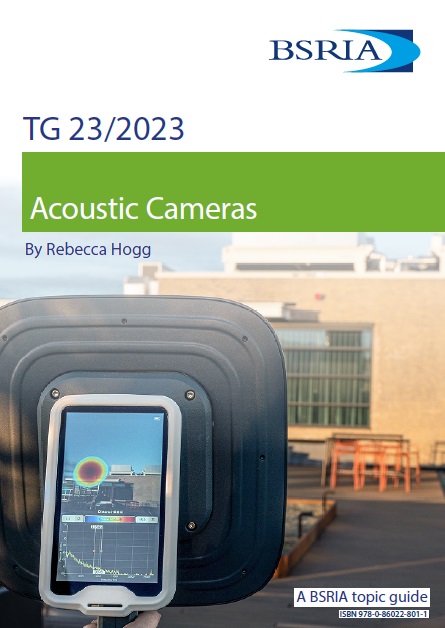Acoustic Cameras (TG 23/2023)
Acoustic Cameras (TG 23/2023) was written by Rebecca Hogg and published by BSRIA in July 2023.
This topic guide provides a broad overview of acoustic cameras – a technology which can be used to visually identify noise sources. It explains how an acoustic camera works, some of the applications of acoustic cameras, and the advantages and disadvantages of using acoustic cameras over other technologies.
Traditionally a sound level meter is used to measure noise levels, in decibels. Investigating noise sources can be achieved by systematically turning on and off noise sources and by using other investigation techniques. When troubleshooting building services systems, there are other investigation techniques that can be used such as vibration monitoring, air and water flow rate measurements, and pressure measurements. When using these, it may also be necessary to turn off systems and dismantle components. The advantage of using an acoustic camera over such investigation techniques is that an acoustic camera does not require systems to be broken into or sensors to be physically attached to a system.
An acoustic camera incorporates an array of microphones. It builds up an image by processing the information received at each of the microphones in the array, which all receive sound waves from the same source at slightly different times. The image produced uses colours to represent sound pressure levels. Typically, bright colours such as yellow are used to represent areas producing the most intense sound whereas darker colours such as purple are used to represent areas producing the least intense sound. The specific colours used, and the range of sound pressure levels represented by these colours, can be selected in the software used by acoustic cameras.
You can download the guide at: https://www.bsria.com/uk/product/rgooar/acoustic_cameras_tg_232023_a15d25e1/
--BSRIA
[edit] Related articles on Designing Buildings
Featured articles and news
Grenfell Tower Principal Contractor Award notice
Tower repair and maintenance contractor announced as demolition contractor.
Passivhaus social homes benefit from heat pump service
Sixteen new homes designed and built to achieve Passivhaus constructed in Dumfries & Galloway.
CABE Publishes Results of 2025 Building Control Survey
Concern over lack of understanding of how roles have changed since the introduction of the BSA 2022.
British Architectural Sculpture 1851-1951
A rich heritage of decorative and figurative sculpture. Book review.
A programme to tackle the lack of diversity.
Independent Building Control review panel
Five members of the newly established, Grenfell Tower Inquiry recommended, panel appointed.
Welsh Recharging Electrical Skills Charter progresses
ECA progressing on the ‘asks’ of the Recharging Electrical Skills Charter at the Senedd in Wales.
A brief history from 1890s to 2020s.
CIOB and CORBON combine forces
To elevate professional standards in Nigeria’s construction industry.
Amendment to the GB Energy Bill welcomed by ECA
Move prevents nationally-owned energy company from investing in solar panels produced by modern slavery.
Gregor Harvie argues that AI is state-sanctioned theft of IP.
Heat pumps, vehicle chargers and heating appliances must be sold with smart functionality.
Experimental AI housing target help for councils
Experimental AI could help councils meet housing targets by digitising records.
New-style degrees set for reformed ARB accreditation
Following the ARB Tomorrow's Architects competency outcomes for Architects.
BSRIA Occupant Wellbeing survey BOW
Occupant satisfaction and wellbeing tool inc. physical environment, indoor facilities, functionality and accessibility.
Preserving, waterproofing and decorating buildings.
























